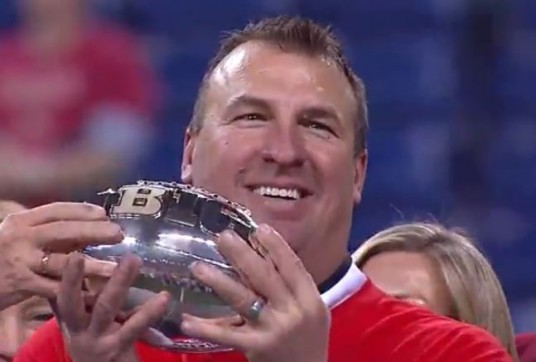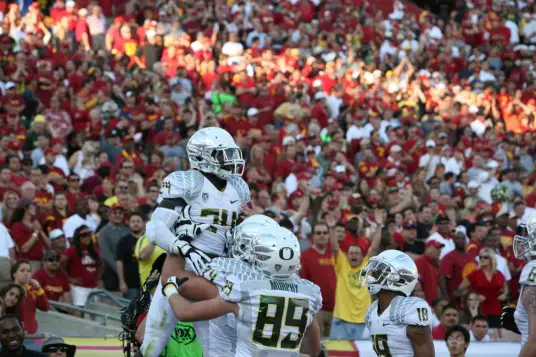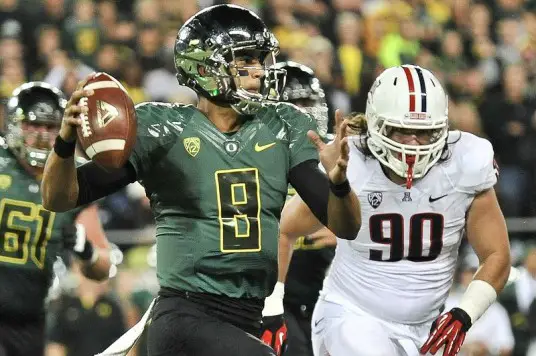“…it has been my longstanding belief that The Big Ten’s schools would forgo the revenues in those circumstances and instead take steps to downsize the scope, breadth and activity of their athletic programs…”
– Big Ten commissioner Jim Delany, on how his member universities would react in the event that college athletes were eligible to be paid.
 It was the old argument come back to life. Back in mid-March, Jim Delany, commissioner of The Big Ten, stated that if student-athletes were eligible to be compensated beyond their scholarships, his conference and its members would likely avoid participating in that model; electing out of continuing to compete in top-level intercollegiate athletics. Once again, Delany had made the argument that schools can be about top-level athletics or academics, but not both.
It was the old argument come back to life. Back in mid-March, Jim Delany, commissioner of The Big Ten, stated that if student-athletes were eligible to be compensated beyond their scholarships, his conference and its members would likely avoid participating in that model; electing out of continuing to compete in top-level intercollegiate athletics. Once again, Delany had made the argument that schools can be about top-level athletics or academics, but not both.
Few in the media believe Delany’s bluff (if that is what it is, as many assume), finding it highly unlikely that those member schools would walk away from millions of dollars (expected to be $25.7 million per school by the end of the 2013 academic year) simply because of a wage increase in the cost of labor. Yet even if his member universities chose to exit the major college sports environment, it still fails to answer the question: Are college athletics and academics really an either-or scenario?
The easiest comparison to Delany’s described model – the likely de-emphasis of athletic departments – is similar to what Ivy League schools did many years ago; ending athletic scholarships and making scholarships for the university’s athletes based entirely around academics or need. His statement implies that college athletics are a luxury enterprise: tolerable to a certain price point, but to be relegated if they ever exceed a certain number.
Compare that statement with the article from Forbes a few weeks ago, describing the University of Alabama, tied for the 77th-ranked university in the country (as rated by U.S. News and World Report) with schools like the Colorado School of Mines and SUNY College of Environmental Science and Forestry, as a destination school for students all across the country, largely on the merits of the athletic program’s success, specifically in football. Similar profiles were written in the wake of Oregon’s run to the BCS title two and a half years ago, which raises the question: Does athletic success actually help academics?
Athletics Impact on Academics
I contacted Roger Thompson, Vice President of Enrollment Management for the University of Oregon, to get his assessment of what impact athletics has had on academics, particularly with regards to enrollment. His answer was not surprising to anyone familiar with the dynamics of how exposure works.
“The biggest reason athletics is so successful in helping us recruit students is not only the amount of media exposure the school gets, but how cost-effective it is, too. When games are on TV, it is hours of free exposure we wouldn’t otherwise be able to afford.”
The impact is noticeable. Following a 7-6 football season in 2006, The University of Oregon received 12,000 applications for enrollment for the class beginning in fall 2007. By the fall 2009 enrollment class, that number had grown to 16,800. For this fall’s class (2013), the university received 23,000 applications. Over that same time frame, Ducks football managed to appear in four consecutive BCS bowls, becoming one of only four schools ever to do so. The growth in applicants overlapping the program’s success isn’t lost on the administration.
“The run in 2010 really piqued the interest of applicants across the country,” Thompson said. “The recent success of the athletic department, especially the football program, has had in the last few years has really allowed us to capitalize on that momentum.”
He added that the exposure also allowed the university to put itself in the minds of applicants beyond the Rockies, the school’s normal recruiting boundary, mentioning that there were large clusters of applicants from places like Pennsylvania, where the university has historically not concentrated its recruiting efforts.
“There really can’t be any other explanation,” he adds.
It is not just success in football that has mattered. Yes, the Ducks have had tremendous football success, but this year men’s basketball won 20 games for the third consecutive season, the first time in school history. The timing of those successes over the academic calendar is critical, says Thompson.
“Students submit applications during fall term (football), and then they make their college choices and submit their deposits during winter term (basketball). Being successful in both really helps students decide to come to Oregon.”
Out-of-state enrollment
It has been a controversial topic in recent years amongst some Oregon residents; the admission of a growing number of out-of-state enrollees and the increased recruiting efforts outside the state that have come with it.
“People may not realize that the number of high school graduates in the state of Oregon plateaued in 2010 and are currently declining, as they are in most of the Western states,” said Thompson. “In order to keep up, we have to increase our market share elsewhere.”
What about the retention of that increased market share? Students may be coming to Oregon due to the success of athletics, but are they staying once they enroll? More than ever, he says.
“Currently, we’re seeing an 86%, almost 87% retention rate. In-state enrollees are at 88%, with out-of-state just slightly below than that, but they’re still retaining at a higher rate than the 83-85% we have had at the university historically,” adding that his goal is for the school to get to 90% retention by 2020.
As for the quality of those students coming to Eugene, amongst them those who chose the school due to success in athletics, Thompson states that the last three classes are the most talented and diverse the university has ever enrolled.
Enrolling Male Students
According to Forbes, males make up 44% of enrollees at public universities in the United States. Even more concerning for schools, the gap between female and male enrollment is widening. The question for schools becomes, “how do we attract male enrollees?”
48% of enrollees at Oregon are male, nearly ten percent higher than the national average for public universities, and not surprisingly, a lot of that has to do with success in sports.
“The success we have had in sports has helped because it creates a brand, and brand matters as much as anything, especially for males,” Thompson says.
Oregon isn’t alone in using sports, specifically football, as a catalyst to spurring male enrollment.
Elsewhere in Oregon, Pacific University in Forest Grove, resurrected its Division III football program after a 19-year hiatus in 2010. The result was a freshman class enrollment of 500 students, believed to be the largest freshman class in school history. 140 of those would try out for football, 110 of whom would make the team.
The addition of the football program at Pacific wasn’t just a one-year novelty hiccup. Enrollment has increased 12% from 2010, the first year of the program, to 2012, and the female-male ratio has reduced from 64-36 to 58-42 over that span, leading other schools around the state of Oregon to follow suit.
In 2014, George Fox University, located in Newberg, will resurrect its football program after a 45-year hiatus behind Chris Casey, the high school coach of incoming Oregon freshman Thomas Tyner at Aloha. The main reason the school is adding football? To increase enrollment and close the enrollment gender gap, the way Pacific has.
“Football has everything to do with it,” Pacific athletic director Ken Schumann told the Oregonian in 2010.
Why Delany’s argument doesn’t work
 To reiterate, if Jim Delany is to be believed, the Big Ten’s primary course of action in the event that collegiate athletes would be eligible for compensation, would be to adopt an Ivy League-style model. Unfortunately for the Big Ten, and no offense to the member schools of that conference, of whom there are many fine academic institutions, but they are not the Ivy League.
To reiterate, if Jim Delany is to be believed, the Big Ten’s primary course of action in the event that collegiate athletes would be eligible for compensation, would be to adopt an Ivy League-style model. Unfortunately for the Big Ten, and no offense to the member schools of that conference, of whom there are many fine academic institutions, but they are not the Ivy League.
The Ivy League’s eight member schools (Harvard, Princeton, Yale, Columbia, Penn, Dartmouth, Brown, and Cornell) rank T-1st, T-1st, 3rd, 4th, T-8th, 10th, T-15th, T-15th amongst the nation’s best schools in the U.S. News and World Report‘s rankings. Those schools don’t need football programs to attract students, comprising half of the nation’s top 15 schools. Meanwhile, the Big Ten’s eight highest-rated schools academically (Northwestern, Michigan, Wisconsin, Penn State, Illinois, Ohio State, future member Maryland, and Purdue) rank 12th, 29th, 41st, T-46th, T-46th, T-56th, T-58th and T-65th by comparison. Very good rankings, but if those were to assign numbers like that to player rankings on Signing Day, we would be describing the Ivy League as “cleaning up.”
Additionally, the Ivy League has the financial flexibility to take such a stance, given that every Ivy League school possesses an endowment larger than all but two Big Ten schools (Michigan, Northwestern), and those two schools’ $7 billion+ endowments are still dwarfed by the coffers of schools like Princeton ($17B), Yale ($19B), and Harvard ($32B).
Consider it from the perspective of an applicant: for those applying to Ivy League schools, if accepted, are likely deciding amongst other Ivy League schools. For those accepted to a Big Ten school, many of which are public/land-grant universities, the competition for enrollees is far more open. With a top-level football program, Michigan is a top-30 academic institution with the winningest tradition in college football. Without such a program, what distinguishes their quality academic institution to a potential enrollee from Division III Tufts (28th), other than they are ranked one slot below?
It is why the Big Ten can never, and will never, give up top-level football. At a time when populations are already migrating away from the Rust Belt and eroding the population bases of those states, to remove their greatest attraction Big Ten schools have over other similarly academically-ranked schools – a football tradition – in an era when schools across the country are adding football programs to increase enrollment would be tantamount to institutional suicide. Football is too important to these schools, both for institutional pride and for academic success. It turns out that winning on the scoreboard isn’t just good for those sitting in the stands and in front of their TVs, but those sitting in the classroom, too.
Related Articles:
Chip Kelly Update: Everything's Good Again ...
Chip Kelly Update: Wailing and Gnashing of Teeth
Shock and Awe -- The Oregon Ducks' Football Hangover Effect
Despite Lopsided Score, Georgia State "Never Stopped Believing"
Hope Springs Eternal for Ducks
Incompetent Pac-12 Officials: How Do You Miss ALL of THIS?
Nathan Roholt is a senior writer and managing editor emeritus for FishDuck. Follow him on Twitter @nathanroholt. Send questions/feedback/hatemail to nroholtfd@gmail.com.





